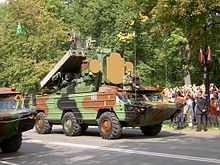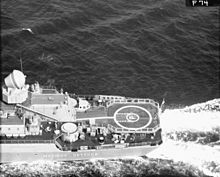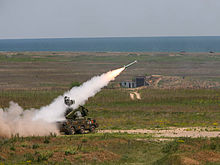- 9K33 Osa
-
"SA-8" redirects here. For the Apollo flight, see A-104 (SA-8).
9K33 Osa
(NATO reporting name: SA-8 Gecko)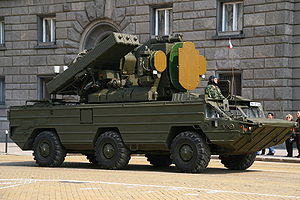
9K33 OSA transporter erector launcher and radar(TELAR)Type 6x6 amphibious SAM system Place of origin  Soviet Union
Soviet UnionService history In service 1972-present Used by See list of present and former operator Wars 1982 Lebanon War, Angolan Civil War, Persian Gulf War, 2011 Libyan uprising Production history Designer NII-20 Research Institute Designed 1965-1972 Produced 1980 Variants OSA-A, OSA-K, OSA-AK, OSA-AKM, OSA-M Specifications (OSA-AKM) Weight 17.5 tonnes Length 9.14 m Width 2.75 m Height 4.20 m (radar mast stowed) Crew 5 soldiers Main
armament6 9M33, 9M33M1, 9M33M2 or 9M33M3 missiles Engine D20K300 diesel Ground clearance 400 mm Operational
range500 km Speed 80 km/h
8 km/h (swimming)The 9K33 OSA (Russian: Оса; English: wasp) is a highly mobile, low-altitude, short-range tactical surface-to-air missile system. "9K33" is its GRAU designation. Its NATO reporting name is SA-8 Gecko.
Contents
Description
The SA-8 was the first mobile air defense missile system incorporating its own engagement radars on a single vehicle.
All versions of the 9K33 feature all-in-one 9A33 transporter erector launcher and radar(TELAR) vehicles which can detect, track and engage aircraft independently or with the aid of regimental surveillance radars. The 6-wheeled transport vehicles are fully amphibious and air transportable. The road range is about 500 km.
The radar system on the SA-8 TELAR received the NATO codename Land Roll, it was derived from the naval `Pop Group' radar system but is smaller since it does not require the elaborate stabilisation system. An improved system designated the SA-8B `Gecko' Mod 1, was first seen in Germany in 1980. It had improvements added to the launcher configuration, carrying six missiles in ribbed containers. The system is reported to be of the frequency-agile monopulse type. It consists of an elliptical rotating surveillance antenna mounted on top of the array, operates in H band (6 to 8 GHz) and has a 30 km acquisition range against most targets. The large pulsed J band (14.5 GHz) engagement antenna is mounted below it in the centre of the array and has a maximum tracking range of about 20 km.
Mounted on either side of the tracking radar antenna is a small J band parabolic dish antenna to track the missile. Below this is a small circular antenna which emits an I band uplink capture beam to gather the missile shortly after launch. The final antennas in the array are two small white rectangular ones, one on either side of the array mounted alongside the I band. These are used for command uplink to the missile. This twin antenna system permits the 'Land Roll' radar to control up to two missiles simultaneously against a single target. Furthermore the two missiles can be guided on different frequencies to further complicate ECM. There is also a tubular device fitted to and above the tracking radar, this is a EO/LLLTV optical tracker. This can be used to track the target when the main tracking radar is jammed by ECM.
An 9K33 battery comprises four 9A33B TELAR vehicles and two 9T217 transloader vehicles with reload missiles. A reload time of five minutes has been reported per TELAR.
In addition to the TELARs, each regiment is also assigned a single radar collimation vehicle on the same chassis as the TELAR (BAZ-5937). This vehicle assists in the alignment of the TELAR's radar systems, ensuring accurate target tracking and engagement.
Variants
- 9K33 "OSA" (US DoD designation SA-8A "Gecko") began development in 1960 and was introduced in 1971-1972 with four exposed 9M33 missiles per TELAR and a maximum range of 12 km (7.5 mi).
- 9K33M "OSA-M" (NATO reporting name SA-N-4 "Gecko") was introduced in 1972 and is the naval version of the system with two 9M33M missiles on a Zif-122 retractable rotating launcher and improved performance. It has been installed on Kara class guided missile cruisers, Kiev class VTOL cruisers and also the Kirov, Slava and Krivak classes.
- 9K33M2 "OSA-AK" (US DoD designation SA-8B "Gecko Mod-0") was introduced in 1975 with the new six-missile box launcher, each missile being a sealed round.
- 9K33M3 "OSA-AKM" (US DoD designation SA-8B "Gecko Mod-1") was introduced in 1980 with the maximum range extended to 15 km (9.3 mi) and maximum altitude to 12 km (40,000 ft) as explained above. Most OSA-AKM systems also feature an IFF antenna.
- Saman and Saman-M (Russian Саман – adobe) is a development of the OSA\OSA-M system into target drones, used for testing and training with air defense systems, including SAMs.
The 9K33M3 is also able[citation needed] to utilize the 9A33BM3 missiles which are wire-guided, presumably for use in an ECM-heavy environment where the radio command guidance may not operate properly.
Missiles
9M33 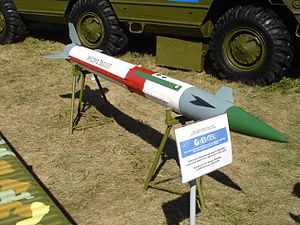
The 9M33M3 missileType Surface-to-air missile Place of origin  Soviet Union
Soviet UnionProduction history Variants 9M33, 9M33M1, 9M33M2, 9M33M3, 9A33BM3 Specifications (9M33[1]) Weight 170 kg Length 3158 mm Diameter 209.6 mm Warhead Frag-HE Warhead weight 16 kg Detonation
mechanismContact and proximity Propellant Solid propellant rocket motor Operational
range15 kilometres (9.3 mi) Flight altitude 12,000 metres (39,000 ft) Boost time 2 s boost, then 15 s sustain Speed 1020 m/s Guidance
systemRF CLOS Steering
systemdual-thrust rocket motor. Accuracy 5 m Launch
platform9P35M2 Engagement range for the early versions is approximately 2–9 km (1.3-5.6 miles) and engagement altitudes of between 50–5000 m (164-16,400 ft). The 9M33M2 "OSA-A" missile extends the ranges out to 1500-10000m (1-6.2 miles) and engagement altitudes to 25–5000 m (82-16,400 ft). The 9M33M3 missile greatly enhances the altitude engagement envelope to 10–12000 m (33-42,500 ft), and as such are also able to fly further (about 15 km/9 miles) but the system is not able to engage targets at longer ranges, due to other factors such as the radar tracking of the missiles. The system is designed for use primarily against jet aircraft and helicopters in any kind of weather.
The 9K33 missiles are 3.158 m (10.3 ft) long, weigh 126 kg (278 lb) and use command guidance. There is also a backup low-light optical tracking system for heavy ECM environments. The latest 9K33M3 missiles have the increased total weight of 170 kg (375 lb) in order to provide the extended range coverage and larger warhead. Propulsion is provided by a dual-thrust solid fuel rocket motor. Both versions feature a missile speed of around Mach 2.4 (peaking at around Mach 3) for a maximum target engagement speed of around Mach 1.4 for the original missile and Mach 1.6 for the M2\M3 missiles. The warhead for the initial and M2 versions weighs 19 kg (42 pounds), increased to 40 kg (88 lb) in the M3 version to improve performance against helicopters. All versions have impact and proximity fuzes.
There have been unconfirmed reports of other possible versions of the missile with both infra-red and semi-active radar terminal homing seekers.
Each TELAR is able to launch and guide two missiles against one target simultaneously. Kill probability is quoted as being 0.35-0.85 for the OSA and 0.55-0.85 for the OSA-AK and OSA-AKM (presumably depending upon target aspect, speed, maneuverability and radar cross section). Reaction time (from target detection to launch) is around 26 seconds. Time to prepare for engagements from being in transit is around 4 minutes and missile reloading takes around 5 minutes. Each battery of four TELARs is usually accompanied by two reload vehicles carrying 18 missiles in sets of three, with a crane mounted on the reload vehicles to assist in moving the missiles.
When launched the booster motor burns for two seconds, this permits the radar to gather and control it at very short ranges (about 1.6 km). The sustainer motor has a 15 second burn, bringing the missile to a top speed of about Mach 2. Once launched the missile is command-guided for the whole flight, and the warhead is detonated by its proximity fuze or possible command. The warhead is said to have a lethal radius of 5 m at low altitude against a F-4 Phantom size target.[citation needed]
Radars
- "Land Roll" C band target acquisition radar, H band conical scan target tracking radar and two J band pulse mode fire control radars (range 35 km/22 miles for acquisition, 30 km/19 miles for tracking and 25 km/16 miles for guidance)
- P-40 "Long Track" E band early warning radar (also used by the SA-4 and SA-6, range 175 km/108 miles)
- P-15 "Flat Face" or P-15M(2) "Squat Eye" 380 kW C band target acquisition radar (also used by the SA-3 and SA-6, range 250 km/155 miles)
- "Thin Skin-B" E band height finding radar (also used by the SA-4 and SA-6, range 240 km/148 miles)
"Land Roll" is mounted on the TELAR, "Long Track" on a tracked vehicle (a modified AT-T), "Flat Face" on a van and "Thin Skin" is mounted on a truck. "Land Roll" has a 360 degree sweep for target acquisition but a more limited cone in which it can track and engage targets.
Deployment and History
As well as the USSR/Russia, there are many export customers for this system, including Cuba, Greece (from the former East Germany), Poland, Syria, Ecuador and Iraq. In late 80's Cuba deployed several SA-8 units in southern Angola and posed a significant threat to South African air superiority at shorter ranges.[2] Iraq used Osa systems during the 1991 Gulf War. Elements of the South African 32 Battalion captured a complete SA-8 anti-aircraft missile system on 3 October 1987 during the Battle of Cuito Cuanavale. This was the first time that such a system had ever fallen into non-Warsaw Pact forces hands, giving Western intelligence agencies an opportunity to examine an important Soviet-bloc weapon system.[3] The system was also seen used in the 2008 South Ossetia War by both Georgians and Russians. Libyan SA-8s were used and some destroyed during the 2011 Libyan war. [4][5]
Operators
 Algeria - 24
Algeria - 24 Albania
Albania Armenia
Armenia Azerbaijan
Azerbaijan Belarus - 350 SA-8
Belarus - 350 SA-8 Bulgaria - 24 missile launch units
Bulgaria - 24 missile launch units- Cameroon -20 missile launch units
 Cuba - 16
Cuba - 16 Ecuador
Ecuador Georgia
Georgia Greece - 39
Greece - 39 India
India Jordan - 60 upgraded
Jordan - 60 upgraded Libya - 20
Libya - 20 Poland - 64
Poland - 64 Romania - 16 launchers and 8 reloaders (one regiment in service since 1989)
Romania - 16 launchers and 8 reloaders (one regiment in service since 1989) Russia - 550 [6]
Russia - 550 [6] Sahrawi Arab Democratic Republic
Sahrawi Arab Democratic Republic Syria - 60
Syria - 60 Turkmenistan - 40 [7]
Turkmenistan - 40 [7] Ukraine
Ukraine
Former Operators
 Czechoslovakia - one regiment which passed to the Czech Republic
Czechoslovakia - one regiment which passed to the Czech Republic Czech Republic - Phased out in 2006
Czech Republic - Phased out in 2006 East Germany - sold to Greece after the German reunification
East Germany - sold to Greece after the German reunification Kuwait - Captured by the Iraqi forces in the Persian Gulf War
Kuwait - Captured by the Iraqi forces in the Persian Gulf War Soviet Union - Passed on to successor states
Soviet Union - Passed on to successor states Yugoslavia - SA-N-4, passed on to successor states
Yugoslavia - SA-N-4, passed on to successor states Yugoslavia - SA-N-4
Yugoslavia - SA-N-4
References
External links
Notes
- ^ "9K33M3 Osa-AKM". http://www.fas.org/man/dod-101/sys/missile/row/sa-8.htm. Retrieved 2008-07-13..
- ^ George, Edward in: The Cuban Intervention in Angola, 1965-1991, Frank Cass, London, New York, 2005, ISBN 0-415-35015-8, p. 236-237
- ^ Turton, A.R. 2010. Shaking Hands with Billy. Durban: Just Done Publications.
- ^ http://www.armyrecognition.com/march_2011_news_defense_military_army_industry_uk/several_libyan_arrmored_vehicles_and_anti-aircraft_systems_destroy_by_the_coalition_forces_2003115.html
- ^ http://edition.cnn.com/2011/WORLD/africa/03/22/libya.civil.war/index.html?hpt=T1
- ^ Russian Army Equipment
- ^ Turkmen-Army Equipment
Russian, Ukrainian, and former Soviet armoured fighting vehicles after World War II Tanks Armoured personnel carriers TrackedWheeledInfantry fighting vehicles Self-propelled artillery Guns- 2S1 Gvozdika
- 2S3 Akatsiya
- 2S4 Tyulpan
- 2S5 Giatsint
- 2S7 Pion
- 2S9 Nona
- 2S19 Msta
- 2S23 Nona-SVK
- 2S25 Sprut-SD
- 2S30 Iset
- 2S31 Vena
- ASU-57
- ASU-85
- A-222 Bereg
- 2K6 Luna (FROG-3/5)
- 9K52 Luna-M (FROG-7)
- 9K79 Tochka (SS-21 Scarab)
- R-400 Oka (SS-23 Spider)
- Iskander (SS-26 Stone)
- K-300P Bastion-P
Self-propelled anti-aircraft weapons GunsCategories:- Cold War surface-to-air missiles of the Soviet Union
- Air defence vehicles of the Soviet Union
- Air defence vehicles of Russia
- Self-propelled anti-aircraft weapons
- Iraq War guided missiles
Wikimedia Foundation. 2010.

